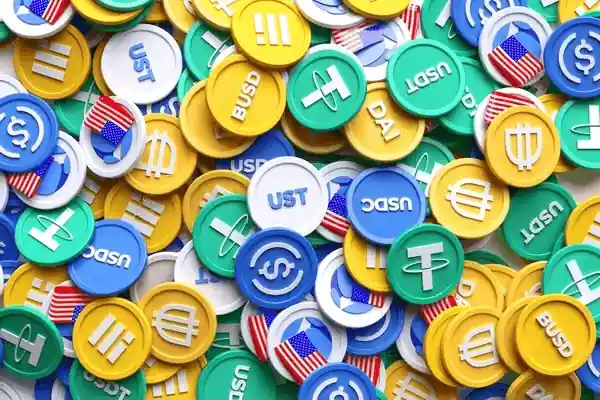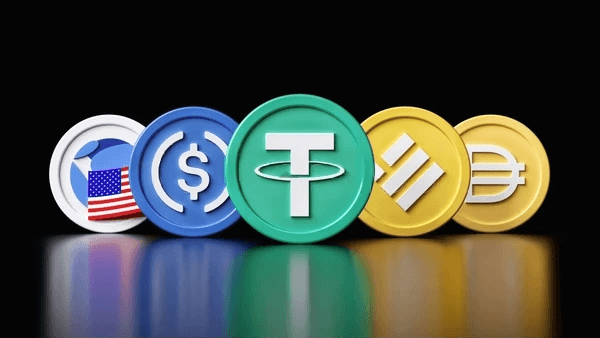Stablecoins are digital currency coins that have, as their name suggests, been created to maintain price stability. Unlike other cryptocurrencies, which fluctuate widely, stablecoins peg their value to a fiat currency, such as the US dollar ($). That means they maintain a fixed price for that fiat currency, regardless of market fluctuations. Understanding why prices fluctuate can be challenging for those new to cryptocurrency trading. A stablecoin is a digital currency that maintains the value of another asset for an extended period and, therefore, can be held over the longer term. You can think of stablecoins as digital versions of traditional financial instruments like gold or silver certificates. The goal is to create a digital currency that combines the benefits of cryptocurrency (such as fast transactions and low fees) with the stability of traditional currencies. Let's explore how stablecoins work and how you can benefit from their use. You may already have the USDC stablecoin in your PlasBit wallet, and we will take a closer look at why this particular stablecoin is so respected.
How Stablecoins Work
As you have read, a stablecoin is a cryptocurrency designed to hold a stable value against an underlying fiat currency, such as the US dollar. Here is a step-by-step explanation of how stablecoins are created and issued:
- A stablecoin issuer creates a new stablecoin and mints a certain number of tokens.
- The issuer then backs the stablecoin with a reserve of assets equal to or greater than the total value of the tokens in circulation. This reserve can be made up of fiat currencies, commodities, or other cryptocurrencies.
- The stablecoin value is pegged to that of the reserve assets. For example, if the stablecoin is pegged to the US dollar, the reserve will be USD.
- When someone wants to buy a stablecoin, they send the issuer the corresponding amount of fiat currency or other assets to which the stablecoin is pegged. The issuer then mints the equivalent number of stablecoin tokens and sends them to the buyer.
- When someone wants to sell stablecoins, they can redeem them with the issuer in exchange for the underlying assets. This ensures that the stablecoin maintains its value, as the issuer is always willing to buy back the tokens at the same price they were sold.
- The stablecoin can be used for transactions like any other cryptocurrency but with the added benefit of price stability.
- A stablecoin uses a reserve of assets to maintain a stable value relative to a specific currency or commodity. This creates an attractive option for people who want to use cryptocurrency for transactions without worrying about price volatility. If you buy 1 USD worth of the USDC stablecoin using your PlasBit wallet, you can receive 1 USD worth of the stablecoin at some point in the future.
Benefits of Stablecoins
Stablecoins are an excellent option for crypto users who want to diversify their portfolios with low-risk assets. They are also helpful for businesses looking to create immutable records of their transactions.
- Lower Risk - Compared to tokens that experience more significant price movement, stablecoins offer a lower-risk option because they are generally less volatile than other cryptocurrencies.
- Low Transaction Fees - Some cryptocurrencies incur high transaction fees. With stablecoins, generally lower transaction fees are paid, as you will see when sending USDC from your PlasBit wallet.
- Reduced Volatility - Stablecoins do not usually fluctuate wildly in price like other cryptocurrencies, which is suitable for those who want to protect their assets.
- Store of Value - Some people see cryptocurrencies as a potential store of value that could become more valuable over time. Stablecoins could potentially become a more desirable store of value too.
- No Mining - The mining process utilized to produce Bitcoin (BTC) attracts increasing controversy as one of the main threats to decentralized blockchain technology. Stablecoins are generally not mined, so they pose less of a threat in this way.
- Easy to Transfer - Stablecoins are easy to transfer, making them a good option for users who want to move their digital assets and diversify their portfolios.
Risks of Stablecoins
While the benefits of stablecoins significantly outweigh the risks, it is still essential to be aware of the weaknesses of this particular type of digital currency.
- Centralized Entity - A centralized entity backs stablecoins, making them more prone to fraud than truly decentralized tokens.
- Asset Exchange Risk - The value of a stablecoin is determined by multiple factors, including the price of the pegged fiat currency and a basket of other assets. Therefore, there is a risk that the stablecoin's value could change dramatically if there is a financial crash or collapse.
- Rising Interest Rates - If interest rates rise, the value of a stablecoin could decrease.

Getting it Wrong: TerraUSD (UST)
The TerraUSD (UST) stablecoin, powered by Luna (LUNA) tokens, was an experimental digital asset invented in 2018 and intended to serve as a medium of exchange between different blockchain networks. In 2022 it collapsed, losing 95% of its value in days. This event has raised questions about the viability of stablecoins to genuinely become a means of payment and the security of blockchain networks. Luna was a controversial project from the start. The team behind it consisted of several individuals with significant experience in digital currency but no specific experience in stablecoins. The coin was also intended to be backed by a basket of assets, including real estate and gold, but this proved expensive and time-consuming. What emerged was UST as an algorithmic stablecoin. Luna functioned as the main reserve asset for Terra and was also used as a governance token for voting on community proposals. A complex model was supposed to maintain its peg by taking advantage of a two-token system - with one token intended to remain stable (UST) and the other (LUNA) meant to absorb volatility. The collapse of Luna is particularly concerning because it occurred on a major cryptocurrency exchange. The failure of a stablecoin is always likely to cause widespread panic, potentially leading to a rash of price fluctuations and market volatility. Several factors contributed to the collapse of Luna. First, the team behind the coin lacked experience in cryptocurrency and blockchain technology. Second, the coin was intended to be backed by a basket of assets, but this was switched to a peg based on algorithms and the project's own Luna token. Finally, the coin was launched on significant cryptocurrency exchanges, which made it vulnerable to price fluctuations and market volatility.
Getting it Right: USDC.
In 2013, Jeremy Allaire and Sean Neville founded Circle, a fintech company to leverages blockchain technology to construct a global financial system that is more open, equitable, and efficient. Later, in 2018, Circle and Coinbase, a prominent crypto exchange, created the CENTRE Consortium, aiming to create a stablecoin. From that venture, USDC (USD Coin) was born in September 2018. A regulated stablecoin, USDC, is pegged to the US dollar, each token representing one US dollar. To ensure its value, the token is subject to periodic audits and is supported by USD reserves held by certified financial organizations. Since its inception, USDC has been accepted widely in the cryptocurrency market and used for trading, payments, and remittances. The USDC Coin is designed to give users a convenient way to store and use cryptocurrencies. In addition, the team is committed to providing quality customer service and ensuring the stability of the USDC coin value.
How to Buy Stablecoins
There are several ways to purchase stablecoins, the most popular being through a cryptocurrency exchange or a crypto wallet.
- Cryptocurrency Exchange - Many cryptocurrency exchanges let you trade other cryptocurrencies for stablecoins. You can also purchase a cryptocurrency and swap it into a stablecoin as required.
- Crypto Wallet - Users can register for a crypto wallet with several stablecoins. A crypto wallet serves as a store for your coins, allowing you to manage multiple types of assets. Using your PlasBit wallet, you can convert fiat currency into the popular and secure USDC token.
The Future of Stablecoins
Stablecoins offer several advantages over traditional forms of currency. For example, they may provide increased liquidity and trustless exchange while reducing price volatility risk. However, some challenges must be addressed for stablecoin use to become widespread. For example, there is a need for a robust infrastructure to support the broader use of these tokens. Additionally, regulators must be comfortable with stablecoins and allow them to be used in various markets. Tether (USDT) is widely believed to be the largest stablecoin in circulation, with a market cap of over $60 billion at the time of writing. US dollars back it, but there has often been speculation about whether the reserves held are sufficient to guarantee the peg. However, cooperating with regulators and providing 'proof of reserves' has already ensured user confidence in the stablecoin. Overall, there is growing transparency around stablecoins generally that can only benefit this type of cryptocurrency in the long term. Many believe that the rise of Central Bank Digital Currencies (CBDCs) will eventually bring mainstream adoption and legitimacy to stablecoins, perhaps even replacing currency as we currently know it. Therefore, it is a great time to get confident transacting with stablecoins using your PlasBit crypto wallet. They are one aspect of cryptocurrency and blockchain technology that will likely be around in one format or another for a long time.







